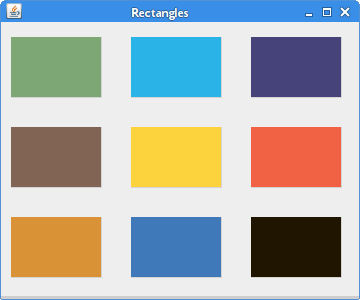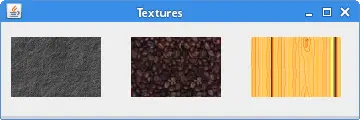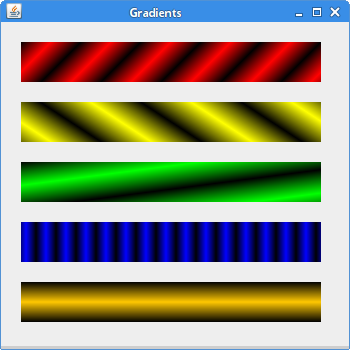Painting in Swing
last modified July 10, 2024
Swing's painting system is able to render vector graphics, images, and outline font-based text.
Painting is needed in applications when we want to change or enhance an existing widget, or if we are creating a custom widget from scratch To do the painting, we use the painting API provided by the Swing toolkit.
The painting is done within the paintComponent method. In the
painting process, we use the Graphics2D object.
Swing 2D Vector Graphics
There are two different computer graphics: vector and raster graphics. Raster graphics represents images as a collection of pixels. Vector graphics is the use of geometrical primitives such as points, lines, curves or polygons to represent images. These primitives are created using mathematical equations.
Both types of computer graphics have advantages and disadvantages. The advantages of vector graphics over raster are:
- smaller size
- ability to zoom indefinitely
- moving, scaling, filling or rotating does not degrade the quality of an image
Types of primitives
- points
- lines
- polylines
- polygons
- circles
- ellipses
- Splines
Swing drawing points
The most simple graphics primitive is point. It is a single dot on the window.
There is no method to draw a point in Swing. To draw a point, we use the
drawLine method. We use one point twice.
package com.zetcode;
import javax.swing.JFrame;
import javax.swing.JPanel;
import java.awt.Color;
import java.awt.EventQueue;
import java.awt.Graphics;
import java.awt.Graphics2D;
import java.util.Random;
class DrawPanel extends JPanel {
private void doDrawing(Graphics g) {
var g2d = (Graphics2D) g;
g2d.setColor(Color.blue);
for (int i = 0; i <= 1000; i++) {
var size = getSize();
var insets = getInsets();
int w = size.width - insets.left - insets.right;
int h = size.height - insets.top - insets.bottom;
var r = new Random();
int x = Math.abs(r.nextInt()) % w;
int y = Math.abs(r.nextInt()) % h;
g2d.drawLine(x, y, x, y);
}
}
@Override
public void paintComponent(Graphics g) {
super.paintComponent(g);
doDrawing(g);
}
}
public class PointsEx extends JFrame {
public PointsEx() {
initUI();
}
private void initUI() {
var drawPanel = new DrawPanel();
add(drawPanel);
setSize(350, 250);
setTitle("Points");
setLocationRelativeTo(null);
setDefaultCloseOperation(JFrame.EXIT_ON_CLOSE);
}
public static void main(String[] args) {
EventQueue.invokeLater(() -> {
var ex = new PointsEx();
ex.setVisible(true);
});
}
}
One point is difficult to observe; therefore, we randomly draw one thousand points on the panel surface.
class DrawPanel extends JPanel {
We are drawing on a custom drawing panel, which is a JPanel
component. The drawing panel will later be added to a JFrame
component.
@Override
public void paintComponent(Graphics g) {
super.paintComponent(g);
doDrawing(g);
}
Custom painting is performed inside the paintComponent method,
which we override. The super.paintComponent method calls the method
of the parent class. It does some necessary work to prepare component for
drawing. Actual drawing is delegated to the doDrawing method.
var g2d = (Graphics2D) g;
Painting in Swing is done on the Graphics2D object.
g2d.setColor(Color.blue);
We will paint our points in blue colour.
var size = getSize(); var insets = getInsets();
The size of the window includes borders and titlebar. We do not paint there.
int w = size.width - insets.left - insets.right; int h = size.height - insets.top - insets.bottom;
Here we calculate the area, where we will effectively paint our points.
var r = new Random(); int x = Math.abs(r.nextInt()) % w; int y = Math.abs(r.nextInt()) % h;
We get a random number in range of the size of area that we computed above.
g2d.drawLine(x, y, x, y);
Here we draw the point. As we already said, we use a drawLine
method. We specify the same point twice.

Swing drawing lines
A line is a simple graphics primitive. It is drawn using two points.
package com.zetcode;
import java.awt.BasicStroke;
import java.awt.EventQueue;
import java.awt.Graphics;
import java.awt.Graphics2D;
import javax.swing.JFrame;
import javax.swing.JPanel;
class DrawPanel extends JPanel {
private void doDrawing(Graphics g) {
var g2d = (Graphics2D) g;
float[] dash1 = {2f, 0f, 2f};
float[] dash2 = {1f, 1f, 1f};
float[] dash3 = {4f, 0f, 2f};
float[] dash4 = {4f, 4f, 1f};
g2d.drawLine(20, 40, 250, 40);
var bs1 = new BasicStroke(1, BasicStroke.CAP_BUTT,
BasicStroke.JOIN_ROUND, 1.0f, dash1, 2f);
var bs2 = new BasicStroke(1, BasicStroke.CAP_BUTT,
BasicStroke.JOIN_ROUND, 1.0f, dash2, 2f);
var bs3 = new BasicStroke(1, BasicStroke.CAP_BUTT,
BasicStroke.JOIN_ROUND, 1.0f, dash3, 2f);
var bs4 = new BasicStroke(1, BasicStroke.CAP_BUTT,
BasicStroke.JOIN_ROUND, 1.0f, dash4, 2f);
g2d.setStroke(bs1);
g2d.drawLine(20, 80, 250, 80);
g2d.setStroke(bs2);
g2d.drawLine(20, 120, 250, 120);
g2d.setStroke(bs3);
g2d.drawLine(20, 160, 250, 160);
g2d.setStroke(bs4);
g2d.drawLine(20, 200, 250, 200);
}
@Override
public void paintComponent(Graphics g) {
super.paintComponent(g);
doDrawing(g);
}
}
public class LinesEx extends JFrame {
public LinesEx() {
initUI();
}
private void initUI() {
var drawPanel = new DrawPanel();
add(drawPanel);
setSize(280, 270);
setTitle("Lines");
setLocationRelativeTo(null);
setDefaultCloseOperation(JFrame.EXIT_ON_CLOSE);
}
public static void main(String[] args) {
EventQueue.invokeLater(() -> {
var ex = new LinesEx();
ex.setVisible(true);
});
}
}
In the example, we draw five lines. The first line is drawn using the default
values. Other will have a different stroke. The stroke is created using
the BasicStroke class. It defines a basic set of rendering
attributes for the outlines of graphics primitives.
float[] dash1 = { 2f, 0f, 2f };
Here we create a dash that we use in the stroke object.
var bs1 = new BasicStroke(1, BasicStroke.CAP_BUTT,
BasicStroke.JOIN_ROUND, 1.0f, dash1, 2f )
This code creates a stroke. The stroke defines the line width, end caps, line joins, miter limit, dash and the dash phase.

Swing drawing rectangles
To draw rectangles, we use the drawRect method. To fill rectangles
with the current color, we use the fillRect method.
package com.zetcode;
import java.awt.Color;
import java.awt.EventQueue;
import java.awt.Graphics;
import java.awt.Graphics2D;
import javax.swing.JFrame;
import javax.swing.JPanel;
class DrawPanel extends JPanel {
private void doDrawing(Graphics g) {
var g2d = (Graphics2D) g;
g2d.setColor(new Color(212, 212, 212));
g2d.drawRect(10, 15, 90, 60);
g2d.drawRect(130, 15, 90, 60);
g2d.drawRect(250, 15, 90, 60);
g2d.drawRect(10, 105, 90, 60);
g2d.drawRect(130, 105, 90, 60);
g2d.drawRect(250, 105, 90, 60);
g2d.drawRect(10, 195, 90, 60);
g2d.drawRect(130, 195, 90, 60);
g2d.drawRect(250, 195, 90, 60);
g2d.setColor(new Color(125, 167, 116));
g2d.fillRect(10, 15, 90, 60);
g2d.setColor(new Color(42, 179, 231));
g2d.fillRect(130, 15, 90, 60);
g2d.setColor(new Color(70, 67, 123));
g2d.fillRect(250, 15, 90, 60);
g2d.setColor(new Color(130, 100, 84));
g2d.fillRect(10, 105, 90, 60);
g2d.setColor(new Color(252, 211, 61));
g2d.fillRect(130, 105, 90, 60);
g2d.setColor(new Color(241, 98, 69));
g2d.fillRect(250, 105, 90, 60);
g2d.setColor(new Color(217, 146, 54));
g2d.fillRect(10, 195, 90, 60);
g2d.setColor(new Color(63, 121, 186));
g2d.fillRect(130, 195, 90, 60);
g2d.setColor(new Color(31, 21, 1));
g2d.fillRect(250, 195, 90, 60);
}
@Override
public void paintComponent(Graphics g) {
super.paintComponent(g);
doDrawing(g);
}
}
public class RectanglesEx extends JFrame {
public RectanglesEx() {
initUI();
}
private void initUI() {
var drawPanel = new DrawPanel();
add(drawPanel);
setSize(360, 300);
setTitle("Rectangles");
setLocationRelativeTo(null);
setDefaultCloseOperation(JFrame.EXIT_ON_CLOSE);
}
public static void main(String[] args) {
EventQueue.invokeLater(() -> {
var ex = new RectanglesEx();
ex.setVisible(true);
});
}
}
In the example we draw nine coloured rectangles.
g2d.setColor(new Color(212, 212, 212)); g2d.drawRect(10, 15, 90, 60); ...
We set the colour of the outline of the rectangle to a soft gray colour, so that
it does not interfere with the fill colour. To draw the outline of the
rectangle, we use the drawRect method. The first two parameters are
the x and y values. The third and fourth are width and height.
g2d.fillRect(10, 15, 90, 60);
To fill the rectangle with a colour, we use the fillRect method.

Swing using textures
A texture is a bitmap image applied to a shape. To work with textures in Java
2D, we use the TexturePaint class.
package com.zetcode;
import javax.imageio.ImageIO;
import javax.swing.JFrame;
import javax.swing.JOptionPane;
import javax.swing.JPanel;
import java.awt.EventQueue;
import java.awt.Graphics;
import java.awt.Graphics2D;
import java.awt.Rectangle;
import java.awt.TexturePaint;
import java.awt.image.BufferedImage;
import java.io.File;
import java.io.IOException;
class DrawingPanel extends JPanel {
private BufferedImage slate;
private BufferedImage java;
private BufferedImage pane;
public DrawingPanel() {
loadImages();
}
private void loadImages() {
try {
slate = ImageIO.read(new File("src/resources/slate.png"));
java = ImageIO.read(new File("src/resources/java.png"));
pane = ImageIO.read(new File("src/resources/pane.png"));
} catch (IOException ex) {
JOptionPane.showMessageDialog(this,
"Could not load images", "Error", JOptionPane.ERROR_MESSAGE);
System.exit(1);
}
}
private void doDrawing(Graphics g) {
var g2d = (Graphics2D) g.create();
var slateTp = new TexturePaint(slate, new Rectangle(0, 0, 90, 60));
var javaTp = new TexturePaint(java, new Rectangle(0, 0, 90, 60));
var paneTp = new TexturePaint(pane, new Rectangle(0, 0, 90, 60));
g2d.setPaint(slateTp);
g2d.fillRect(10, 15, 90, 60);
g2d.setPaint(javaTp);
g2d.fillRect(130, 15, 90, 60);
g2d.setPaint(paneTp);
g2d.fillRect(250, 15, 90, 60);
g2d.dispose();
}
@Override
public void paintComponent(Graphics g) {
super.paintComponent(g);
doDrawing(g);
}
}
public class TexturesEx extends JFrame {
public TexturesEx() {
initUI();
}
private void initUI() {
var drawingPanel = new DrawingPanel();
add(drawingPanel);
setTitle("Textures");
setSize(360, 120);
setLocationRelativeTo(null);
setDefaultCloseOperation(JFrame.EXIT_ON_CLOSE);
}
public static void main(String[] args) {
EventQueue.invokeLater(() -> {
var ex = new TexturesEx();
ex.setVisible(true);
});
}
}
In the code example, we fill three rectangles with three different textures.
private BufferedImage slate; private BufferedImage java; private BufferedImage pane;
BufferedImage is a rectangle of pixels stored in memory. It is one
of the most important image types in Swing. Many Swing methods return a
BufferedImage
to work with.
slate = ImageIO.read(new File("src/resources/slate.png"));
Here we read the image into the buffered image using ImageIO.read
method. It takes a File object and returns a BufferedImage.
slateTp = new TexturePaint(slate, new Rectangle(0, 0, 90, 60));
We create a TexturePaint class out of the buffered image.
g2d.setPaint(slateTp); g2d.fillRect(10, 15, 90, 60);
We fill a rectangle with the texture.

Using gradients
In computer graphics, gradient is a smooth blending of shades from light to dark or from one colour to another. In 2D drawing programs and paint programs, gradients are used to create colourful backgrounds and special effects as well as to simulate lights and shadows.
package com.zetcode;
import java.awt.Color;
import java.awt.EventQueue;
import java.awt.GradientPaint;
import java.awt.Graphics;
import java.awt.Graphics2D;
import javax.swing.JFrame;
import javax.swing.JPanel;
class DrawPanel extends JPanel {
private void doDrawing(Graphics g) {
var g2d = (Graphics2D) g;
var gp1 = new GradientPaint(5, 5,
Color.red, 20, 20, Color.black, true);
g2d.setPaint(gp1);
g2d.fillRect(20, 20, 300, 40);
var gp2 = new GradientPaint(5, 25,
Color.yellow, 20, 2, Color.black, true);
g2d.setPaint(gp2);
g2d.fillRect(20, 80, 300, 40);
var gp3 = new GradientPaint(5, 25,
Color.green, 2, 2, Color.black, true);
g2d.setPaint(gp3);
g2d.fillRect(20, 140, 300, 40);
var gp4 = new GradientPaint(25, 25,
Color.blue, 15, 25, Color.black, true);
g2d.setPaint(gp4);
g2d.fillRect(20, 200, 300, 40);
var gp5 = new GradientPaint(0, 0,
Color.orange, 0, 20, Color.black, true);
g2d.setPaint(gp5);
g2d.fillRect(20, 260, 300, 40);
}
@Override
public void paintComponent(Graphics g) {
super.paintComponent(g);
doDrawing(g);
}
}
public class GradientsEx extends JFrame {
public GradientsEx() {
initUI();
}
private void initUI() {
var drawPanel = new DrawPanel();
add(drawPanel);
setSize(350, 350);
setTitle("Gradients");
setLocationRelativeTo(null);
setDefaultCloseOperation(JFrame.EXIT_ON_CLOSE);
}
public static void main(String[] args) {
EventQueue.invokeLater(() -> {
var ex = new GradientsEx();
ex.setVisible(true);
});
}
}
Our code example presents five rectangles with gradients.
var gp4 = new GradientPaint(25, 25,
Color.blue, 15, 25, Color.black, true);
To work with gradients, we use Java Swing's GradientPaint class.
By manipulating the colour values and the starting end ending points, we can get
different types of gradients.
g2d.setPaint(gp5);
The gradient is activated calling the setPaint method.

Drawing text
Drawing is done with the drawString method. We specify
the string we want to draw and the position of the text on the window area.
package com.zetcode;
import javax.swing.JFrame;
import javax.swing.JPanel;
import java.awt.EventQueue;
import java.awt.Font;
import java.awt.Graphics;
import java.awt.Graphics2D;
import java.awt.RenderingHints;
class DrawPanel extends JPanel {
private void doDrawing(Graphics g) {
var g2d = (Graphics2D) g;
var rh = new RenderingHints(
RenderingHints.KEY_ANTIALIASING,
RenderingHints.VALUE_ANTIALIAS_ON);
rh.put(RenderingHints.KEY_RENDERING,
RenderingHints.VALUE_RENDER_QUALITY);
g2d.setRenderingHints(rh);
var font = new Font("URW Chancery L", Font.BOLD, 21);
g2d.setFont(font);
g2d.drawString("Not marble, nor the gilded monuments", 20, 30);
g2d.drawString("Of princes, shall outlive this powerful rhyme;", 20, 60);
g2d.drawString("But you shall shine more bright in these contents",
20, 90);
g2d.drawString("Than unswept stone, besmear'd with sluttish time.",
20, 120);
g2d.drawString("When wasteful war shall statues overturn,", 20, 150);
g2d.drawString("And broils root out the work of masonry,", 20, 180);
g2d.drawString("Nor Mars his sword, nor war's quick "
+ "fire shall burn", 20, 210);
g2d.drawString("The living record of your memory.", 20, 240);
g2d.drawString("'Gainst death, and all oblivious enmity", 20, 270);
g2d.drawString("Shall you pace forth; your praise shall still "
+ "find room", 20, 300);
g2d.drawString("Even in the eyes of all posterity", 20, 330);
g2d.drawString("That wear this world out to the ending doom.", 20, 360);
g2d.drawString("So, till the judgment that yourself arise,", 20, 390);
g2d.drawString("You live in this, and dwell in lovers' eyes.", 20, 420);
}
@Override
public void paintComponent(Graphics g) {
super.paintComponent(g);
doDrawing(g);
}
}
public class DrawingTextEx extends JFrame {
public DrawingTextEx() {
initUI();
}
private void initUI() {
var drawPanel = new DrawPanel();
add(drawPanel);
setSize(500, 470);
setTitle("Sonnet55");
setLocationRelativeTo(null);
setDefaultCloseOperation(JFrame.EXIT_ON_CLOSE);
}
public static void main(String[] args) {
EventQueue.invokeLater(() -> {
var ex = new DrawingTextEx();
ex.setVisible(true);
});
}
}
In our example, we draw a sonnet on the panel component.
var rh = new RenderingHints(
RenderingHints.KEY_ANTIALIASING,
RenderingHints.VALUE_ANTIALIAS_ON);
rh.put(RenderingHints.KEY_RENDERING,
RenderingHints.VALUE_RENDER_QUALITY);
g2d.setRenderingHints(rh);
This code is to make our text look better. We apply a technique
called antialiasing using RenderingHints.
var font = new Font("URW Chancery L", Font.BOLD, 21);
g2d.setFont(font);
We choose a specific font for our text.
g2d.drawString("Not marble, nor the gilded monuments", 20, 30);
This is the code that draws the text.
Drawing image
On of the most important capabililies of a toolkit is the ability to display
images. An image is an array of pixels. Each pixel represents a colour at a
given position. We can use components like JLabel to display an
image, or we can draw it using the Java 2D API.
package com.zetcode;
import javax.swing.ImageIcon;
import javax.swing.JFrame;
import javax.swing.JPanel;
import java.awt.Dimension;
import java.awt.EventQueue;
import java.awt.Graphics;
import java.awt.Graphics2D;
import java.awt.Image;
class DrawPanel extends JPanel {
private Image myImage;
public DrawPanel() {
initPanel();
}
private void initPanel() {
loadImage();
var dm = new Dimension(myImage.getWidth(null), myImage.getHeight(null));
setPreferredSize(dm);
}
private void loadImage() {
myImage = new ImageIcon("src/resources/icesid.jpg").getImage();
}
private void doDrawing(Graphics g) {
var g2d = (Graphics2D) g;
g2d.drawImage(myImage, 0, 0, null);
}
@Override
public void paintComponent(Graphics g) {
super.paintComponent(g);
doDrawing(g);
}
}
public class DrawImageEx extends JFrame {
public DrawImageEx() {
initUI();
}
private void initUI() {
var drawPanel = new DrawPanel();
add(drawPanel);
setTitle("Image");
pack();
setLocationRelativeTo(null);
setDefaultCloseOperation(JFrame.EXIT_ON_CLOSE);
}
public static void main(String[] args) {
EventQueue.invokeLater(() -> {
var ex = new DrawImageEx();
ex.setVisible(true);
});
}
}
This example will draw an image on the panel. The image will fit the
JFrame window.
private void initPanel() {
loadImage();
var dm = new Dimension(img.getWidth(null), img.getHeight(null));
setPreferredSize(dm);
}
In the initPanel method we call the loadImage method.
We determine the image dimensions and set the preffered size of the panel
component. This will together with the pack method display the
image that will exactly fit the window.
private void loadImage() {
myImage = new ImageIcon("src/resources/icesid.jpg").getImage();
}
The method loads an image from the disk. We use the ImageIcon
class. This class simplifies the work with the images in Java Swing.
g2d.drawImage(this.img, 0, 0, null);
The image is drawn using the drawImage method.
In this chapter, we did some painting in Java Swing. Visit the ZetCode's Java 2D tutorial for additional information about painting in Swing.